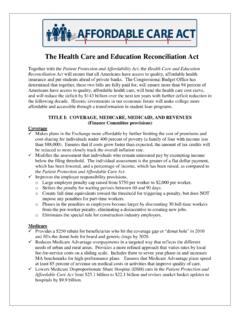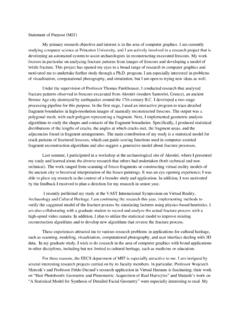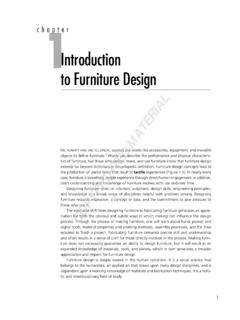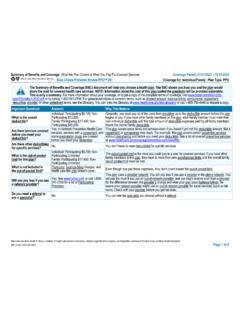Transcription of The Patient Protection and Affordable Care Act Detailed ...
1 The Patient Protection and Affordable care Act Detailed Summary The Patient Protection and Affordable care Act will ensure that all Americans have access to quality, Affordable health care and will create the transformation within the health care system necessary to contain costs. The Congressional Budget Office (CBO) has determined that the Patient Protection and Affordable care Act is fully paid for, ensures that more than 94 percent of Americans have health insurance, bends the health care cost curve, and reduces the deficit by $118 billion over the next ten years and even more in the following decade. The Patient Protection and Affordable care Act addresses essential components of reform: Quality, Affordable health care for all Americans The role of public programs Improving the quality and efficiency of health care Prevention of chronic disease and improving public health Health care workforce Transparency and program integrity Improving access to innovative medical therapies Community living assistance services and supports Revenue provisions Title I.
2 Quality, Affordable Health care for All Americans The Patient Protection and Affordable care Act will accomplish a fundamental transformation of health insurance in the United States through shared responsibility. Systemic insurance market reform will eliminate discriminatory practices by health insurers such as pre-existing condition exclusions. Achieving these reforms without increasing health insurance premiums will mean that all Americans must have coverage. Tax credits for individuals, families, and small businesses will ensure that insurance is Affordable for everyone. These three elements are the essential links to achieving meaningful reform. Immediate Improvements. Implementing health insurance reform will take some time. However, many immediate reforms will take effect in 2010. The Patient Protection and Affordable care Act will: Eliminate lifetime and unreasonable annual limits on benefits, with annual limits prohibited in 2014 Prohibit rescissions of health insurance policies Provide assistance for those who are uninsured because of a pre-existing condition Prohibit pre-existing condition exclusions for children Require coverage of preventive services and immunizations Extend dependant coverage up to age 26 Develop uniform coverage documents so consumers can make apples-to-apples comparisons when shopping for health insurance 2 Cap insurance company non-medical.
3 Administrative expenditures Ensure consumers have access to an effective appeals process and provide consumer a place to turn for assistance navigating the appeals process and accessing their coverage Create a temporary re-insurance program to support coverage for early retirees Establish an internet portal to assist Americans in identifying coverage options Facilitate administrative simplification to lower health system costs Health Insurance Market Reform. Beginning in 2014, more significant insurance reforms will be implemented. Across individual and small group health insurance markets in all states, new rules will end medical underwriting and pre-existing condition exclusions. Insurers will be prohibited from denying coverage or setting rates based on gender, health status, medical condition, claims experience, genetic information, evidence of domestic violence, or other health-related factors. Premiums will vary only by family structure, geography, actuarial value, tobacco use, participation in a health promotion program, and age (by not more than three to one).
4 Available Coverage. A qualified health plan, to be offered through the new American Health Benefit Exchange, must provide essential health benefits which include cost sharing limits. No out-of-pocket requirements can exceed those in Health Savings Accounts, and deductibles in the small group market cannot exceed $2,000 for an individual and $4,000 for a family. Coverage will be offered at four levels with actuarial values defining how much the insurer pays: Platinum 90 percent; Gold 80 percent; Silver 70 percent; and bronze 60 percent. A less costly catastrophic-only plan will be offered to individuals under age 30 and to others who are exempt from the individual responsibility requirement. American Health Benefit Exchanges. By 2014, each state will establish an Exchange to help individuals and small employers obtain coverage. Plans participating in the Exchanges will be accredited for quality, will present their benefit options in a standardized manner for easy comparison, and will use one, simple enrollment form.
5 Individuals qualified to receive tax credits for Exchange coverage must be ineligible for Affordable , employer-sponsored insurance any form of public insurance coverage. Undocumented immigrants are ineligible for premium tax credits. Federal support will be available for new non-profit, member run insurance cooperatives, and the Office of Personnel Management will supervise the offering by private insurers of multi-State plans, available nationwide. States will have flexibility to establish basic health plans for non-Medicaid, lower-income individuals; states may also seek waivers to explore other reform options; and states may form compacts with other states to permit cross-state sale of health insurance. No federal dollars may be used to pay for abortion services. Making Coverage Affordable . New, refundable tax credits will be available for Americans with incomes between 100 and 400 percent of the federal poverty line (FPL) (about $88,000 for a family of four).
6 The credit is calculated on a sliding scale beginning at two percent of income for those at 100 percent FPL and phasing out at percent of income at 300-400 percent FPL. If an employer offer of coverage exceeds percent of a worker s family income, or the employer pays less than 60 percent of the premium, the worker may enroll in the Exchange and receive credits. Out of pocket maximums ($5,950 for individuals and $11,900 for families) are reduced to one-third for those with income between 100-200 percent FPL, one-half for those with incomes between 200-300 percent FPL, and 3 two-thirds for those with income between 300-400 percent FPL. Credits are available for eligible citizens and legally-residing aliens. A new credit will assist small businesses with fewer than 25 workers for up to 50 percent of the total premium cost. Shared Responsibility. Beginning in 2014, most individuals will be responsible for maintaining minimum essential coverage or paying a penalty of $95 in 2014, $495 in 2015 and $750 in 2016, or up to two percent of income by 2016, with a cap at the national average bronze plan premium.
7 Families will pay half the amount for children up to a cap of $2,250 for the entire family. After 2016, dollar amounts will increase by the annual cost of living adjustment. Exceptions to this requirement are made for religious objectors, those who cannot afford coverage, taxpayers with incomes less than 100 percent FPL, Indian tribe members, those who receive a hardship waiver, individuals not lawfully present, incarcerated individuals, and those not covered for less than three months. Any individual or family who currently has coverage and would like to retain that coverage can do so under a grandfather provision. This coverage is deemed to meet the individual responsibility to have health coverage. Similarly, employers that currently offer coverage are permitted to continue offering such coverage under the grandfather policy. Employers with more than 200 employees must automatically enroll new full-time employees in coverage.
8 Any employer with more than 50 full-time employees that does not offer coverage and has at least one full-time employee receiving the premium assistance tax credit will make a payment of $750 per full-time employee. An employer with more than 50 employees that offers coverage that is deemed unaffordable or does not meet the standard for minimum essential coverage and but has at least one full-time employee receiving the premium assistance tax credit because the coverage is either unaffordable or does not cover 60 percent of total costs, will pay the lesser of $3,000 for each of those employees receiving a credit or $750 for each of their full-time employees total. Title II. The Role of Public Programs The Patient Protection and Affordable care Act expands eligibility for Medicaid to lower income persons and assumes federal responsibility for much of the cost of this expansion. It provides enhanced federal support for the Children s Health Insurance Program, simplifies Medicaid and CHIP enrollment, improves Medicaid services, provides new options for long-term services and supports, improves coordination for dual-eligibles, and improves Medicaid quality for patients and providers.
9 Medicaid Expansion. States may expand Medicaid eligibility as early as April 1, 2010. Beginning on January 1, 2014, all children, parents and childless adults who are not entitled to Medicare and who have family incomes up to 133 percent FPL will become eligible for Medicaid. Between 2014 and 2016, the federal government will pay 100 percent of the cost of covering newly-eligible individuals. In 2017 and 2018, states that initially covered less of the newly-eligible population ( Other States ) will receive more assistance than states that covered at least some non-elderly, non-pregnant adults ( Expansion States ). States will be required to maintain the same income eligibility levels through December 31, 2013 for all adults, and this requirement would be extended through September 30, 2019 for children currently in Medicaid. 4 Children s Health Insurance Program. States will be required to maintain income eligibility levels for CHIP through September 30, 2019.
10 The current reauthorization period of CHIP is extended for two years, to September 30, 2015. Between fiscal years 2016 and 2019, states would receive a 23 percentage point increase in the CHIP federal match rate, subject to a 100 percent cap. Simplifying Enrollment. Individuals will be able to apply for and enroll in Medicaid, CHIP and the Exchange through state-run websites. Medicaid and CHIP programs and the Exchange will coordinate enrollment procedures to provide seamless enrollment for all programs. Hospitals will be permitted to provide Medicaid services during a period of presumptive eligibility to members of all Medicaid eligibility categories. Community First Choice Option. A new optional Medicaid benefit is created through which states may offer community-based attendant services and supports to Medicaid beneficiaries with disabilities who would otherwise require care in a hospital, nursing facility, or intermediate care facility for the mentally retarded.








